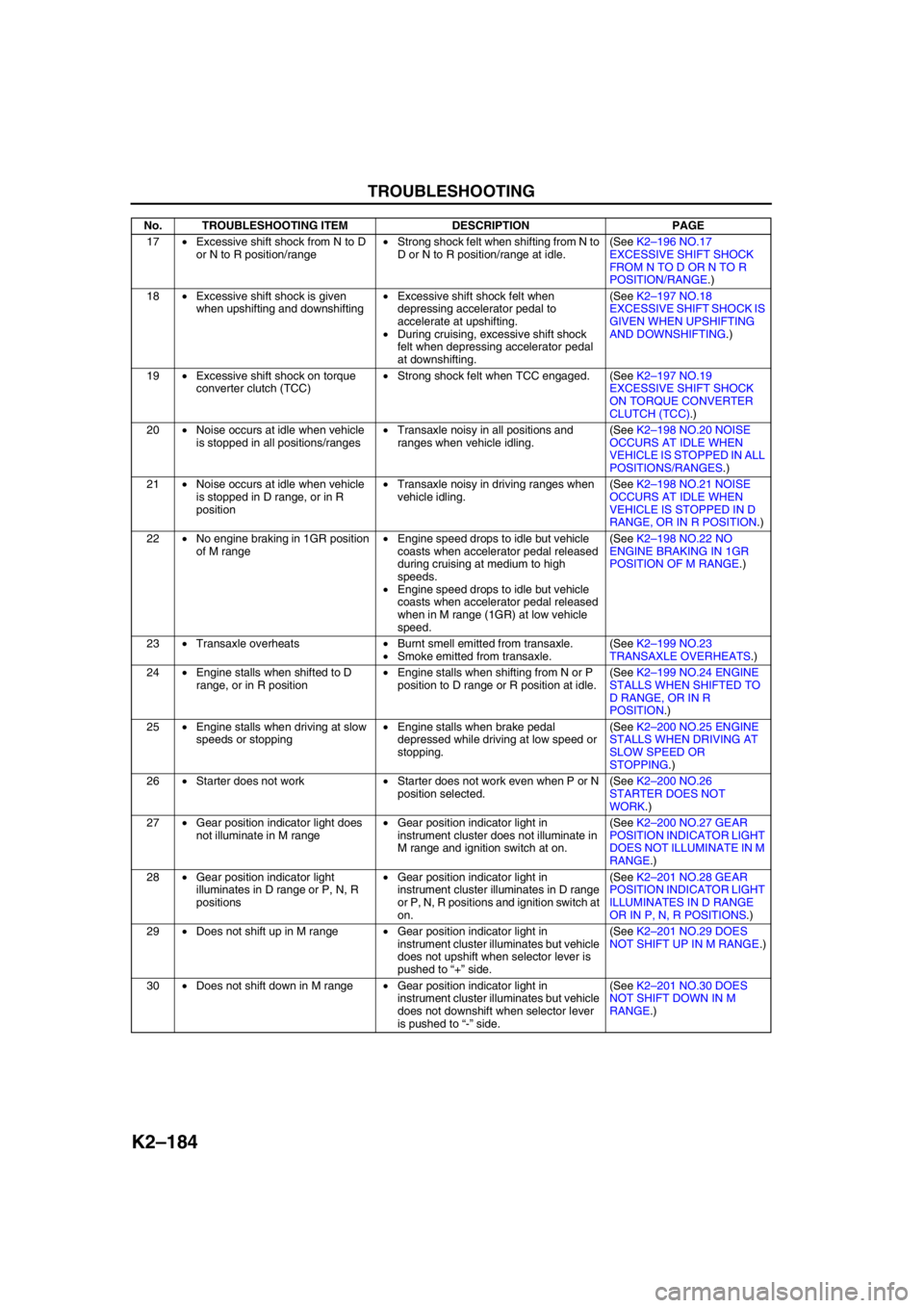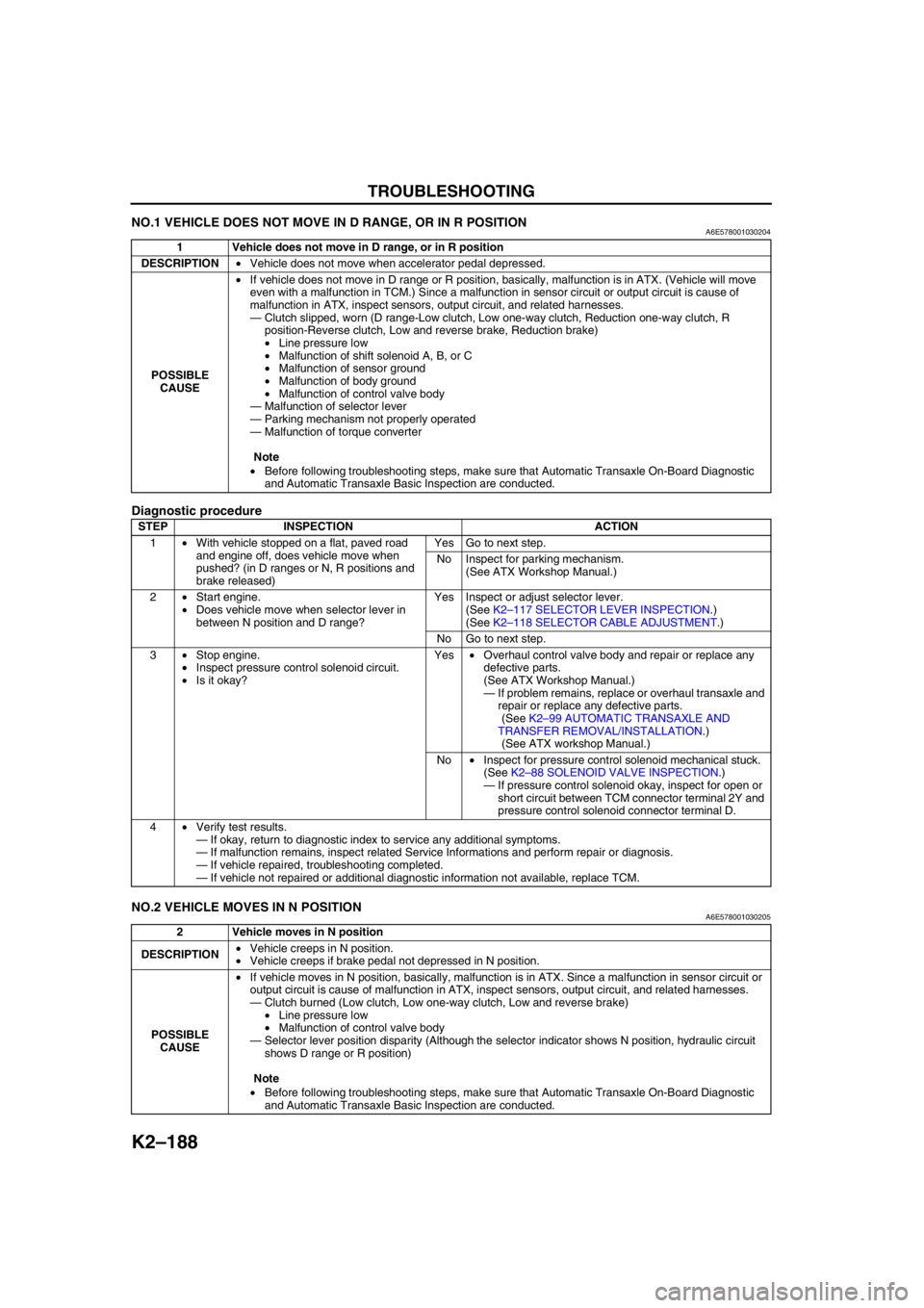stop start MAZDA 6 2002 Suplement User Guide
[x] Cancel search | Manufacturer: MAZDA, Model Year: 2002, Model line: 6, Model: MAZDA 6 2002Pages: 909, PDF Size: 17.16 MB
Page 417 of 909

K2–2
AUTOMATIC TRANSAXLE ON-BOARD
DIAGNOSTIC FUNCTION .......................... K2-123
AFTER REPAIR PROCEDURE ..................... K2-124
DTC TABLE ................................................... K2-126
DTC P0705 .................................................... K2-127
DTC P0706 .................................................... K2-129
DTC P0711 .................................................... K2-132
DTC P0712 .................................................... K2-133
DTC P0713 .................................................... K2-135
DTC P0715 .................................................... K2-137
DTC P0720 .................................................... K2-139
DTC P0740 .................................................... K2-142
DTC P0743 .................................................... K2-144
DTC P0748 .................................................... K2-146
DTC P0751 .................................................... K2-149
DTC P0752 .................................................... K2-150
DTC P0753 .................................................... K2-151
DTC P0756 .................................................... K2-153
DTC P0757 .................................................... K2-154
DTC P0758 .................................................... K2-155
DTC P0761 .................................................... K2-158
DTC P0762 .................................................... K2-159
DTC P0763 .................................................... K2-160
DTC P0768 .................................................... K2-163
DTC P0773 .................................................... K2-166
DTC P0778 .................................................... K2-169
DTC P0791 .................................................... K2-172
DTC P0798 .................................................... K2-175
DTC P1710 .................................................... K2-178
PID/DATA MONITOR INSPECTION.............. K2-180
TROUBLESHOOTING...................................... K2-182
FOREWORD .................................................. K2-182
AUTOMATIC TRANSAXLE BASIC
INSPECTION .............................................. K2-182
AUTOMATIC TRANSAXLE SYMPTOM
TROUBLESHOOTING ................................ K2-183
NO.1 VEHICLE DOES NOT MOVE IN
D RANGE, OR IN R POSITION .................. K2-188
NO.2 VEHICLE MOVES IN N POSITION ...... K2-188
NO.3 VEHICLE MOVES IN P POSITION,
OR PARKING GEAR DOES NOT
DISENGAGE WHEN P IS DISENGAGED .. K2-189
NO.4 EXCESSIVE CREEP ............................ K2-189
NO.5 NO CREEP AT ALL .............................. K2-189
NO.6 LOW MAXIMUM SPEED AND
POOR ACCELERATION............................. K2-190
NO.7 NO SHIFTING....................................... K2-191
NO.8 DOES NOT SHIFT TO FIFTH
GEAR (5GR) ............................................... K2-192
NO.9 ABNORMAL SHIFTING ........................ K2-193
NO.10 FREQUENT SHIFTING ...................... K2-193
NO.11 SHIFT POINT IS HIGH OR LOW ....... K2-194
NO.12 TORQUE CONVERTER
CLUTCH (TCC) NON-OPERATION ........... K2-194
NO.13 NO KICKDOWN.................................. K2-195
NO.14 ENGINE FLARES UP OR
SLIPS WHEN UPSHIFTING OR
DOWNSHIFTING ........................................ K2-195
NO.15 ENGINE FLARES UP OR
SLIPS WHEN ACCELERATING VEHICLE. K2-196
NO.16 JUDDER UPON TORQUE
CONVERTER CLUTCH (TCC)
OPERATION ............................................... K2-196NO.17 EXCESSIVE SHIFT SHOCK
FROM N TO D OR N TO R
POSITION/RANGE ..................................... K2-196
NO.18 EXCESSIVE SHIFT SHOCK IS
GIVEN WHEN UPSHIFTING AND
DOWNSHIFTING ........................................ K2-197
NO.19 EXCESSIVE SHIFT SHOCK
ON TORQUE CONVERTER CLUTCH
(TCC) .......................................................... K2-197
NO.20 NOISE OCCURS AT IDLE WHEN
VEHICLE IS STOPPED IN ALL
POSITIONS/RANGES ................................ K2-198
NO.21 NOISE OCCURS AT IDLE
WHEN VEHICLE IS STOPPED IN
D RANGE, OR IN R POSITION .................. K2-198
NO.22 NO ENGINE BRAKING IN 1GR
POSITION OF M RANGE ........................... K2-198
NO.23 TRANSAXLE OVERHEATS ............... K2-199
NO.24 ENGINE STALLS WHEN SHIFTED
TO D RANGE, OR IN R POSITION ............ K2-199
NO.25 ENGINE STALLS WHEN DRIVING
AT SLOW SPEED OR STOPPING ............. K2-200
NO.26 STARTER DOES NOT WORK ........... K2-200
NO.27 GEAR POSITION INDICATOR
LIGHT DOES NOT ILLUMINATE IN
M RANGE ................................................... K2-200
NO.28 GEAR POSITION INDICATOR
LIGHT ILLUMINATES IN D RANGE
OR IN P, N, R POSITIONS ......................... K2-201
NO.29 DOES NOT SHIFT UP IN M RANGE . K2-201
NO.30 DOES NOT SHIFT DOWN IN
M RANGE ................................................... K2-201
Page 490 of 909

AUTOMATIC TRANSAXLE
K2–75
K2
Time Lag Test
1. Perform mechanical system test preparation. (See K2–72 Mechanical System Test Preparation.)
2. Start the engine.
3. Warm up the engine until the ATF temperature reaches 60—70°C {140—158°F}. Shift the selector lever from N
position to D range.
4. Use a stopwatch to measure the time it takes from shifting until engagement is felt. Take three measurements
for each test and average the results using the following formula.
Formula
Average time lag = (Time 1 + Time 2 + Time 3) / 3
5. Perform the test for the following shifts in the same manner.
•N position → P position
Time lag
N → D range ... approx. 0.5—1.0 second
N → R position ... approx. 0.6— 1.0 second
Evaluation of time lag test
End Of SieROAD TESTA6E571401030210Road Test Preparation
1. Inspect the engine coolant. (See Section E.)
2. Inspect the engine oil. (See D–8 ENGINE OIL INSPECTION.)
3. Inspect the ATF levels. (See K2–78 AUTOMATIC TRANSAXLE FLUID (ATF) INSPECTION.)
4. Inspect the idle speed and ignition timing in P position. (See F1–22 IDLE SPEED INSPECTION (4WD).)
5. Bring up the engine and transaxle to normal operating temperature.
Shift Diagram
D range (normal mode)
Condition Possible Cause
Above specificationN → D shiftInsufficient line pressure in all forward ranges
Low clutch slippage
Low one-way clutch slippage
Reduction one-way clutch slippage
N → R shiftInsufficient line pressure in R position
Low and reverse brake slippage
Reverse clutch slippage
Reduction brake slippage
0/8 1/8
2/8
3/8
4/8
5/8
6/8
7/8
8/8
TCC OPERATION AVAILABLE
VEHICLE SPEED km/h {mph}
THROTTLE OPENING
SHIFT UP
4GR
TCC
OFF
SHIFT DOWN
0
{0}20
{12}40
{25}60
{37}80
{50}100
{63}120
{75}140
{87}160
{99}180
{112}220
{137} 200
{124} 112 23
2
2 232
34
4534
45
5GR TCC ON
4GR TCC ON
5GR TCC OFF
A6E5714W104
Page 540 of 909

ON-BOARD DIAGNOSTIC
K2–125
K2
•For P0740
i. Start the engine.
ii. Warm up the engine and ATX.
iii. Drive vehicle under the following conditions for 10 seconds or more.
—Vehicle speed (VSS PID): 76 km/h {47 mph}
—Selector lever position: D range
—TCC operating
iv. Go to Step 5.
•For P0743
i. Start the engine.
ii. Warm up the engine and ATX.
iii. Drive the vehicle in D range and make sure that the gears shift smoothly from 1GR to 5GR and TCC is
operated.
iv. Go to Step 5.
•For P0748, P0751, P0752, P0753, P0756, P0757, P0758, P0761, P0762, P0763, P0768, P0773, P0778,
P0798, P1710, PC073, PC100
i. Start the engine.
ii. Warm up the engine and ATX.
iii. Drive the vehicle in D range and make sure that the gears shift smoothly from 1GR to 5GR.
iv. Go to Step 5.
5. Gradually slow down and stop the vehicle.
6. Make sure that the repaired DTC does not recur.
End Of Sie
Page 599 of 909

K2–184
TROUBLESHOOTING
17•Excessive shift shock from N to D
or N to R position/range•Strong shock felt when shifting from N to
D or N to R position/range at idle.(See K2–196 NO.17
EXCESSIVE SHIFT SHOCK
FROM N TO D OR N TO R
POSITION/RANGE.)
18•Excessive shift shock is given
when upshifting and downshifting•Excessive shift shock felt when
depressing accelerator pedal to
accelerate at upshifting.
•During cruising, excessive shift shock
felt when depressing accelerator pedal
at downshifting.(See K2–197 NO.18
EXCESSIVE SHIFT SHOCK IS
GIVEN WHEN UPSHIFTING
AND DOWNSHIFTING.)
19•Excessive shift shock on torque
converter clutch (TCC)•Strong shock felt when TCC engaged. (See K2–197 NO.19
EXCESSIVE SHIFT SHOCK
ON TORQUE CONVERTER
CLUTCH (TCC).)
20•Noise occurs at idle when vehicle
is stopped in all positions/ranges•Transaxle noisy in all positions and
ranges when vehicle idling.(See K2–198 NO.20 NOISE
OCCURS AT IDLE WHEN
VEHICLE IS STOPPED IN ALL
POSITIONS/RANGES.)
21•Noise occurs at idle when vehicle
is stopped in D range, or in R
position•Transaxle noisy in driving ranges when
vehicle idling.(See K2–198 NO.21 NOISE
OCCURS AT IDLE WHEN
VEHICLE IS STOPPED IN D
RANGE, OR IN R POSITION.)
22•No engine braking in 1GR position
of M range•Engine speed drops to idle but vehicle
coasts when accelerator pedal released
during cruising at medium to high
speeds.
•Engine speed drops to idle but vehicle
coasts when accelerator pedal released
when in M range (1GR) at low vehicle
speed.(See K2–198 NO.22 NO
ENGINE BRAKING IN 1GR
POSITION OF M RANGE.)
23•Transaxle overheats•Burnt smell emitted from transaxle.
•Smoke emitted from transaxle.(See K2–199 NO.23
TRANSAXLE OVERHEATS.)
24•Engine stalls when shifted to D
range, or in R position•Engine stalls when shifting from N or P
position to D range or R position at idle.(See K2–199 NO.24 ENGINE
STALLS WHEN SHIFTED TO
D RANGE, OR IN R
POSITION.)
25•Engine stalls when driving at slow
speeds or stopping•Engine stalls when brake pedal
depressed while driving at low speed or
stopping.(See K2–200 NO.25 ENGINE
STALLS WHEN DRIVING AT
SLOW SPEED OR
STOPPING.)
26•Starter does not work•Starter does not work even when P or N
position selected.(See K2–200 NO.26
STARTER DOES NOT
WORK.)
27•Gear position indicator light does
not illuminate in M range•Gear position indicator light in
instrument cluster does not illuminate in
M range and ignition switch at on.(See K2–200 NO.27 GEAR
POSITION INDICATOR LIGHT
DOES NOT ILLUMINATE IN M
RANGE.)
28•Gear position indicator light
illuminates in D range or P, N, R
positions•Gear position indicator light in
instrument cluster illuminates in D range
or P, N, R positions and ignition switch at
on.(See K2–201 NO.28 GEAR
POSITION INDICATOR LIGHT
ILLUMINATES IN D RANGE
OR IN P, N, R POSITIONS.)
29•Does not shift up in M range•Gear position indicator light in
instrument cluster illuminates but vehicle
does not upshift when selector lever is
pushed to “+” side.(See K2–201 NO.29 DOES
NOT SHIFT UP IN M RANGE.)
30•Does not shift down in M range•Gear position indicator light in
instrument cluster illuminates but vehicle
does not downshift when selector lever
is pushed to “-” side.(See K2–201 NO.30 DOES
NOT SHIFT DOWN IN M
RANGE.) No. TROUBLESHOOTING ITEM DESCRIPTION PAGE
Page 600 of 909

TROUBLESHOOTING
K2–185
K2
Quick Diagnosis Chart
Vehicle dose not move in D range, or in R position X X
X
X
X
X
X
X
X
X
XX X
XX
XX
XX
XX
X X X
X
XX X
XX
X XXXXX
XX X
XX
XX X X
X
X
X XX
X
XX
X
X
XX
X
XXX
X
XXX
X
X X XX
X
XXXX XX
X
XX
X
X X
XX XX
X
X
X 1
Excessive creep 4
No creep at all 5
Low maximum speed and poor acceleration 6
No shifting 7
Does not shift to fifth gear (5GR) 8
Abnormal shifting 9
Frequent shifting 10
Shift point is high or low 11
Torque converter clutch (TCC) non-operation 12
No kickdown 13
Engine flares up or slips when upshifting or downshifting 14
Engine flares up or slip when accelerating vehicle 15
Judder upon torque converter clutch (TCC) operation 16
Excessive shift shock from N to D or N to R position/range 17
Excessive shift shock on torque converter clutch (TCC) 19
No engine braking in 1GR position of M range 22
Transaxle overheats 23
Engine stalls when shifted to D range, or in R position 24
Engine stalls when driving at slow speeds or stopping 25
Starter does not work 26Excessive shift shock is given when upshifting and
downshifting 18
Noise occurs at idle when vehicle is stopped in all
positions/ranges 20
Noise occurs at idle when vehicle is stopped in D
range, or in R position 21
Gear position indicator light illuminates in D range or P, N,
R positions 28Gear position indicator light does not illuminate in M range
Electrical system components
ATX outer parts 27
Does not shift up in M range
29
Does not shift down in M range
Symptom item
Cause of trouble
Selector lever is misadjisted
Not within line pressure specification
Idle speed is misadjusted
IG timing is misadjusted
TR switch is misadjusted
Open/short
Abnormal signal is inputed
Abnormal signal is inputed Signal is not inputed
Signal is not inputed
Abnormal signal is inputed Signal is not inputed
Abnormal signal is inputed Signal is not inputed
Abnormal signal is inputed Signal is not inputed
Abnormal signal is inputed Signal is not inputed
Abnormal signal is inputed
Abnormal signal is inputed Signal is not inputedCAN signal
CAN signal Engine speed signal
Vehicle speedometer sensor
Input/turbine speed sensor
Intermediate sensor
D range switch
M range switch
Up switch
Down switch
Throttle opening
30Vehicle moves in N position 2
Vehicle moves in P position, or parking gear does not
disengage when P is disengaged 3
X X X
X X X
X
X
A6E5780W001
Page 601 of 909

K2–186
TROUBLESHOOTING
CAN signal
Vehicle dose not move in D range, or in R position
X
XXX X
X
X X
X
XX
X
X
X
X
X
XX
XX
XX
XXX
XX
XX
X
XXX X
XX X
XX X
XX X
XXX
XX
X
XX
X XX XX
X
XX
XX
X XX
X XXXX
XXXX
XXXXX XX XXX
X
X
XX
X
X
X
X
X
X
X
X
X
X X
X
X
X X
XXX
XX
XX X X
X 1
Excessive creep 4
No creep at all 5
Low maximum speed and poor acceleration 6
No shifting 7
Does not shift to fifth gear (5GR) 8
Abnormal shifting 9
Frequent shifting 10
Shift point is high or low 11
Torque converter clutch (TCC) non-operation 12
No kickdown 13
Engine flares up or slips when upshifting or downshifting 14
Engine flares up or slip when accelerating vehicle 15
Judder upon torque converter clutch (TCC) operation 16
Excessive shift shock from N to D or N to R position/range 17
Excessive shift shock on torque converter clutch (TCC) 19
No engine braking in 1GR position of M range 22
Transaxle overheats 23
Engine stalls when shifted to D range, or in R position 24
Engine stalls when driving at slow speeds or stopping 25
Starter does not work 26Excessive shift shock is given when upshifting and
downshifting 18
Noise occurs at idle when vehicle is stopped in all
positions/ranges 20
Noise occurs at idle when vehicle is stopped in D
range, or in R position 21
Gear position indicator light illuminates in D range or P, N,
R positions 28Gear position indicator light does not illuminate in M range
Electrical system components
ATX inner parts
ATX outer parts
Hydraulic system
components
Control valve body 27
Does not shift up in M range
29
Does not shift down in M rangeSymptom item
Cause of trouble
Open/short
Malfunction signal is inputed Signal is inputed
Open/short
Open/short Open/short
Open/short
Open/short
Open/short
Open/short
Open/short Open/short
Open/short
Open/short Open/short
Control valve spool is not operating properly ATF amount
2-4 brake accumulator is not operating properly Low clutch solenoid accumulator is not operating properly
Direct clutch accumulator is not operating properly High clutch accumulator is not operating properly2-4 brake solenoid valve Pressure control solenoid
TCC solenoid valve
High clutch solenoid valve TFT sensor N-D select
Transaxle range switch
Power supply, GND
Shift solenoid A
Shift solenoid B
Shift solenoid C
Neutral shift solenoid valve
Reducation timing solenoid
GND return line
30Vehicle moves in N position 2
Vehicle moves in P position, or parking gear does not
disengage when P is disengaged 3
A6E5780W002
Page 602 of 909

TROUBLESHOOTING
K2–187
K2
End Of Sie
Vehicle dose not move in D range, or in R position
X
X
X
XXX X
XX X
XX X
XX X XX
X
X
X X XX
XX
X XXXXXXXXX
XXX
X
X
X X
XX XXX
X
X
XX X
X
X
X X
X
X
X X
XX
X XXX X XXX
XX X 1
Excessive creep 4
No creep at all 5
Low maximum speed and poor acceleration 6
No shifting 7
Does not shift to fifth gear (5GR) 8
Abnormal shifting 9
Frequent shifting 10
Shift point is high or low 11
Torque converter clutch (TCC) non-operation 12
No kickdown 13
Engine flares up or slips when upshifting or downshifting 14
Engine flares up or slip when accelerating vehicle 15
Judder upon torque converter clutch (TCC) operation 16
Excessive shift shock from N to D or N to R position/range 17
Excessive shift shock on torque converter clutch (TCC) 19
No engine braking in 1GR position of M range 22
Transaxle overheats 23
Engine stalls when shifted to D range, or in R position 24
Engine stalls when driving at slow speeds or stopping 25
Starter does not work 26Excessive shift shock is given when upshifting and
downshifting 18
Noise occurs at idle when vehicle is stopped in all
positions/ranges 20
Noise occurs at idle when vehicle is stopped in D
range, or in R position 21
Gear position indicator light illuminates in D range or P, N,
R positions 28Gear position indicator light does not illuminate in M range
Hydraulic system
components
Control valve bodyPowertrain 27
Does not shift up in M range
29
Does not shift down in M range
Symptom item
Cause of trouble
Reduction accumulator is not operating properly
Clogging
Clogging
Clogging
Clogging
Clogging
Clogging
Clogging Clogging
Clogging
Slipping (clutch, brake) Oil cooler is not operating properly
Torque converter is not operating properly Burned (clutch, brake)
TCC piston is not operating properly TCC piston is cracking or peeling2-4 brake solenoid valve hydraulic circuit Pressure control solenoid hydraulic circuit
TCC solenoid valve hydraulic circuit
High clutch solenoid valve hydraulic circuit
Shift solenoid A hydraulic circuit
Shift solenoid B hydraulic circuit
Shift solenoid C hydraulic circuit
Neutral shift solenoid valve
Reducation timing solenoid valve
30Vehicle moves in N position 2
Vehicle moves in P position, or parking gear does not
disengage when P is disengaged 3
A6E5780W003
Page 603 of 909

K2–188
TROUBLESHOOTING
NO.1 VEHICLE DOES NOT MOVE IN D RANGE, OR IN R POSITIONA6E578001030204
Diagnostic procedure
End Of SieNO.2 VEHICLE MOVES IN N POSITIONA6E578001030205
1 Vehicle does not move in D range, or in R position
DESCRIPTION•Vehicle does not move when accelerator pedal depressed.
POSSIBLE
CAUSE•If vehicle does not move in D range or R position, basically, malfunction is in ATX. (Vehicle will move
even with a malfunction in TCM.) Since a malfunction in sensor circuit or output circuit is cause of
malfunction in ATX, inspect sensors, output circuit, and related harnesses.
—Clutch slipped, worn (D range-Low clutch, Low one-way clutch, Reduction one-way clutch, R
position-Reverse clutch, Low and reverse brake, Reduction brake)
•Line pressure low
•Malfunction of shift solenoid A, B, or C
•Malfunction of sensor ground
•Malfunction of body ground
•Malfunction of control valve body
—Malfunction of selector lever
—Parking mechanism not properly operated
—Malfunction of torque converter
Note
•Before following troubleshooting steps, make sure that Automatic Transaxle On-Board Diagnostic
and Automatic Transaxle Basic Inspection are conducted.
STEP INSPECTION ACTION
1•With vehicle stopped on a flat, paved road
and engine off, does vehicle move when
pushed? (in D ranges or N, R positions and
brake released)Yes Go to next step.
No Inspect for parking mechanism.
(See ATX Workshop Manual.)
2•Start engine.
•Does vehicle move when selector lever in
between N position and D range?Yes Inspect or adjust selector lever.
(See K2–117 SELECTOR LEVER INSPECTION.)
(See K2–118 SELECTOR CABLE ADJUSTMENT.)
No Go to next step.
3•Stop engine.
•Inspect pressure control solenoid circuit.
•Is it okay?Yes•Overhaul control valve body and repair or replace any
defective parts.
(See ATX Workshop Manual.)
—If problem remains, replace or overhaul transaxle and
repair or replace any defective parts.
(See K2–99 AUTOMATIC TRANSAXLE AND
TRANSFER REMOVAL/INSTALLATION.)
(See ATX workshop Manual.)
No•Inspect for pressure control solenoid mechanical stuck.
(See K2–88 SOLENOID VALVE INSPECTION.)
—If pressure control solenoid okay, inspect for open or
short circuit between TCM connector terminal 2Y and
pressure control solenoid connector terminal D.
4•Verify test results.
—If okay, return to diagnostic index to service any additional symptoms.
—If malfunction remains, inspect related Service Informations and perform repair or diagnosis.
—If vehicle repaired, troubleshooting completed.
—If vehicle not repaired or additional diagnostic information not available, replace TCM.
2 Vehicle moves in N position
DESCRIPTION•Vehicle creeps in N position.
•Vehicle creeps if brake pedal not depressed in N position.
POSSIBLE
CAUSE•If vehicle moves in N position, basically, malfunction is in ATX. Since a malfunction in sensor circuit or
output circuit is cause of malfunction in ATX, inspect sensors, output circuit, and related harnesses.
—Clutch burned (Low clutch, Low one-way clutch, Low and reverse brake)
•Line pressure low
•Malfunction of control valve body
—Selector lever position disparity (Although the selector indicator shows N position, hydraulic circuit
shows D range or R position)
Note
•Before following troubleshooting steps, make sure that Automatic Transaxle On-Board Diagnostic
and Automatic Transaxle Basic Inspection are conducted.
Page 605 of 909

K2–190
TROUBLESHOOTING
Diagnostic procedure
End Of SieNO.6 LOW MAXIMUM SPEED AND POOR ACCELERATIONA6E578001030209
Diagnostic procedure
STEP INSPECTION ACTION
1•Does vehicle creep in P and/or N position? Yes Inspect or adjust the selector lever.
(See K2–117 SELECTOR LEVER INSPECTION.)
(See K2–118 SELECTOR CABLE ADJUSTMENT.)
No Go to next step.
2•Stop engine.
•Inspect pressure control solenoid circuit.
•Is it okay?Yes Go to next step.
No•Inspect for pressure control solenoid mechanical stuck.
(See K2–88 SOLENOID VALVE INSPECTION.)
—If pressure control solenoid okay, inspect for open or
short circuit between TCM connector terminal 2Y and
pressure control solenoid connector terminal D.
3•Remove torque converter.
•Inspect torque converter.
(See ATX Workshop Manual.)
•Is torque converter okay?Yes•Overhaul control valve body and repair or replace any
defective parts.
(See ATX Workshop Manual.)
—If problem remains, replace or overhaul transaxle and
repair or replace any defective parts.
(See K2–99 AUTOMATIC TRANSAXLE AND
TRANSFER REMOVAL/INSTALLATION.)
(See ATX Workshop Manual.)
No Replace torque converter.
4•Verify test results.
—If okay, return to diagnostic index to service any additional symptoms.
—If malfunction remains, inspect related Service Informations and perform repair or diagnosis.
—If vehicle repaired, troubleshooting completed.
—If vehicle not repaired or additional diagnostic information not available, replace TCM.
6 Low maximum speed and poor acceleration
DESCRIPTION•Vehicle acceleration poor at start.
•Delayed acceleration when accelerator pedal depressed while driving.
POSSIBLE
CAUSE•If clutch is stuck or does not stay in 4GR, malfunction is in engine circuit.
—Clutch slipped, burned
•Line pressure low
•Incorrect throttle position signal
•Malfunction of VSS
•Malfunction of input/turbine speed sensor
•Malfunction of sensor ground
•Malfunction of shift solenoids A, B, or C
•Malfunction of body ground
•Malfunction of control valve body
—Transaxle fixed in 4GR (Operation of fail-safe function)
•Short or open circuit in wiring
•Poor connection of connector
•Electronic parts of output and input system malfunction are malfunctioning
—Insufficient starting torque (Suspected when in-gear condition, shift control and engine circuit are
normal)
•Malfunction of torque converter (Poor operation, sticking)
—Engagement of TCC operation range (Operation of fail-safe function)
•Malfunction of TFT sensor (Short or open circuit)
Note
•Before following troubleshooting steps, make sure that Automatic Transaxle On-Board Diagnostic
and Automatic Transaxle Basic Inspection are conducted.
STEP INSPECTION ACTION
1•With ignition switch at ON, does gear
position indicator light indication correspond
to selector lever position?Yes Go to next step.
No Go to symptom troubleshooting No.27 “Gear position
indicator light does not illuminate in M range”, or No.28
“Gear position indicator light illuminates in D range or P, N,
R position”.
2•Go to symptom troubleshooting No.12 “Lack/
loss of power-acceleration/cruise”.
(See Section F.)
•Does engine control system okay?Yes Go to next step.
No Repair or replace any defective parts according to
inspection results.
Page 615 of 909

K2–200
TROUBLESHOOTING
Diagnostic procedure
End Of SieNO.25 ENGINE STALLS WHEN DRIVING AT SLOW SPEED OR STOPPINGA6E578001030228
Diagnostic procedure
End Of SieNO.26 STARTER DOES NOT WORKA6E578001030229
End Of SieNO.27 GEAR POSITION INDICATOR LIGHT DOES NOT ILLUMINATE IN M RANGEA6E578001030230
Diagnostic procedure
STEP INSPECTION ACTION
1•Go to symptom troubleshooting No.4
“Engine stalls-after start/at idle”.
(See Section F.)
•Is engine control system okay?Yes Go to next step.
No Repair or replace any defective parts according to
inspection results.
2•Remove torque converter.
•Inspect torque converter.
(See ATX Workshop Manual.)
•Is torque converter okay?Yes•Inspect for bend, damage or kinks of oil cooler line
pipes. If okay, overhaul control valve body and repair or
replace any defective parts.
(See ATX Workshop Manual.)
•If problem remains, replace or overhaul transaxle and
repair or replace any defective parts.
(See ATX Workshop Manual.)
No Replace torque converter.
3•Verify test results.
—If okay, return to diagnostic index to service any additional symptoms.
—If malfunction remains, inspect related Service Informations and perform repair or diagnosis.
—If vehicle repaired, troubleshooting completed.
—If vehicle not repaired or additional diagnostic information not available, replace TCM.
25 Engine stalls when driving at slow speeds or stopping
DESCRIPTION•Engine stalls when brake pedal depressed while driving at low speed or stopping.
POSSIBLE
CAUSE•Malfunction is on engine control side (e.g. Fuel injection control, IAC system)
Note
•Before following troubleshooting steps, make sure that Automatic Transaxle On-Board Diagnostic
and Automatic Transaxle Basic Inspection are conducted.
STEP INSPECTION ACTION
1•Go to symptom troubleshooting No.10 “Low
idle/stalls during deceleration”.
(See Section F.)
•Is engine control system okay?Yes Go to symptom troubleshooting No.24 “Engine stalls when
shifted to D range, or in R position”.
No Repair or replace any defective parts according to
inspection results.
2•Verify test results.
—If okay, return to diagnostic index to service any additional symptoms.
—If malfunction remains, inspect related Service Informations and perform repair or diagnosis.
—If vehicle repaired, troubleshooting completed.
—If vehicle not repaired or additional diagnostic information not available, replace TCM.
26Starter does not work
DESCRIPTION•Starter does not work even when P or N position.
POSSIBLE
CAUSE•Selector lever misadjustment.
•TR switch misadjustment.
•Open or short circuit in TR switch.
27 Gear position indicator light does not illuminate in M range
DESCRIPTION•Gear position indicator light in instrument cluster does not illuminate in M range and ignition switch at
on.
POSSIBLE
CAUSE•M range switch, gear position indicator light or related wiring harness malfunction.
Note
•Before following troubleshooting steps, make sure that Automatic Transaxle On-Board Diagnostic
and Automatic Transaxle Basic Inspection are conducted.
STEP INSPECTION ACTION
1•Are other indicator lights illuminated with
ignition switch on? Yes Go to next step.
No Inspect meter fuse.